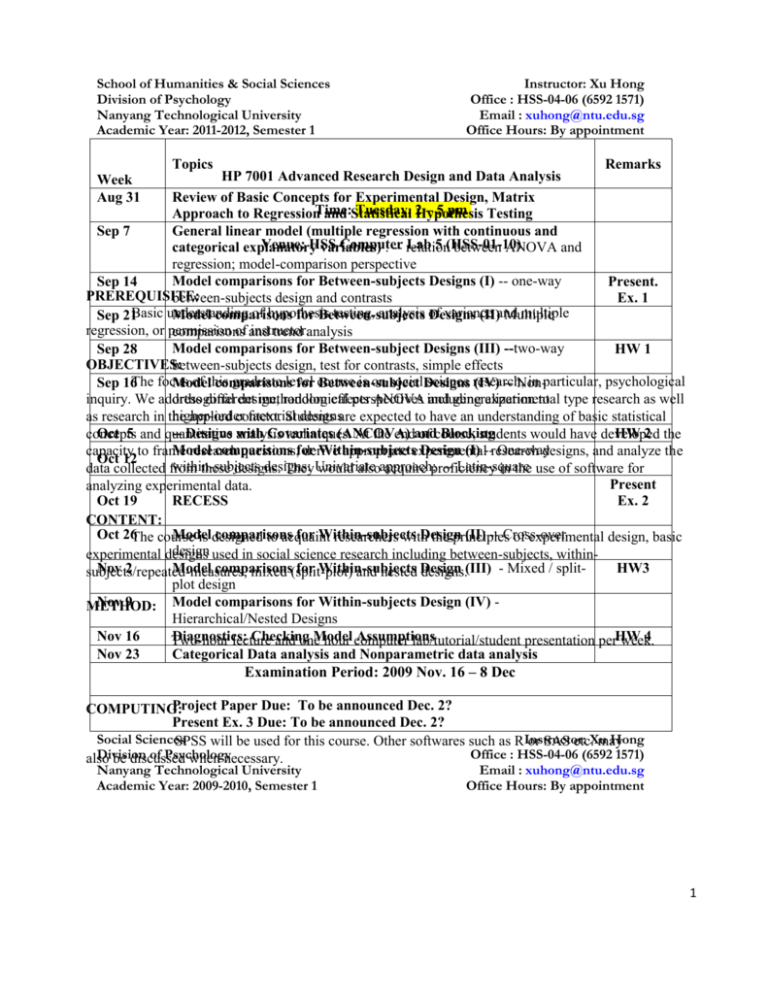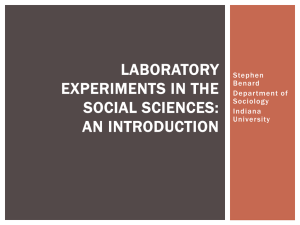
School of Humanities & Social Sciences
Division of Psychology
Nanyang Technological University
Academic Year: 2011-2012, Semester 1
Instructor: Xu Hong
Office : HSS-04-06 (6592 1571)
Email : xuhong@ntu.edu.sg
Office Hours: By appointment
Topics
Remarks
HP 7001 Advanced Research Design and Data Analysis
Review of Basic Concepts for Experimental Design, Matrix
Tuesday, 2Hypothesis
– 5 pm Testing
Approach to RegressionTime:
and Statistical
Sep 7
General linear model (multiple regression with continuous and
Venue: HSS
Computer
Lab 5 (HSS-01-10)
categorical explanatory
variables)
: -- relation
between ANOVA and
regression; model-comparison perspective
Model comparisons for Between-subjects Designs (I) -- one-way
Sep 14
Present.
PREREQUISITE:
between-subjects design and contrasts
Ex. 1
of hypothesis
testing, analysis of
variance
multiple
Model comparisons
for Between-subjects
Designs
(II)and
Multiple
Sep 21Basic understanding
regression, or permission
of and
instructor.
comparisons
trend analysis
Model comparisons for Between-subject Designs (III) --two-way
Sep 28
HW 1
OBJECTIVES:
between-subjects design, test for contrasts, simple effects
of this
graduate level
is on socialDesigns
science research,
in particular, psychological
Model
comparisons
for course
Between-subject
(IV) -- NonSep 16The focus
inquiry. We address
orthogonal
different
design,
methodological
random effects
perspectives
ANOVA including
and generalization
experimental
to type research as well
higher-order
factorial
designsare expected to have an understanding of basic statistical
as research in the
applied context.
Students
Oct 5 and quantitative
-- Designs analysis
with Covariates
(ANCOVA)
Blocking
HW 2 the
concepts
techniques.
At the endand
of course,
students would have developed
Model
comparisons
Within-subjects
Design (I) --research
One-way
capacity to frame
research
questions,for
derive
appropriate experimental
designs, and analyze the
Oct 12
within-subjects
designs:
-- Latin-square
data collected from
these designs.
TheyUnivariate
would alsoapproach;
acquire proficiency
in the use of software for
Present
analyzing experimental data.
Oct 19
RECESS
Ex. 2
CONTENT:
Model
comparisons
for Within-subjects
Design
(II) -- Cross-over
Oct 26The course
is designed
to acquaint
researchers with
the principles
of experimental design, basic
design
experimental designs used in social science research including between-subjects, withinModel comparisons
for Within-subjects
Nov 2
HW3
subjects/repeated-measures,
mixed (split-plot)
and nested Design
designs.(III) - Mixed / splitplot design
Model comparisons for Within-subjects Design (IV) Nov 9
METHOD:
Hierarchical/Nested Designs
Nov 16
Diagnostics:
Checking
Assumptions
4
Two-hour
lecture
and oneModel
hour computer
lab/tutorial/student presentation perHW
week.
Nov 23
Categorical Data analysis and Nonparametric data analysis
Examination Period: 2009 Nov. 16 – 8 Dec
Week
Aug 31
Project Paper Due: To be announced Dec. 2?
COMPUTING:
Present Ex. 3 Due: To be announced Dec. 2?
Social Sciences
Hong
SPSS will be used for this course. Other softwares such as RInstructor:
or SAS etc.Xu
may
Division
of
Psychology
Office
:
HSS-04-06
(6592
1571)
also be discussed when necessary.
Nanyang Technological University
Email : xuhong@ntu.edu.sg
Academic Year: 2009-2010, Semester 1
Office Hours: By appointment
1
TEXTBOOKS:
Maxwell, S. E., & Delaney, H. D. (2004).
Designing experiments and analyzing data: A model comparison
nd
perspective (2 ed.). Lawrence Erlbaum Associates, Inc.
RECOMMENDED REFERENCES:
th
Keppel, G., & Wickens, T. D. (2004) Design and analysis: A researcher’s handbook (4 ed.).
Pearson, Prentice Hall.
Kirk, R. E. (1995). Experimental design: Procedures for the behavioral sciences.
Brooks/Cole Publishing Company.
Shadish, W. R., Cook, T. D., & Campbell, D. T. (2001). Experimental and quasiexperimental designs for generalized causal inference. Houghton Mifflin Company.
Tabachnick, B. G., & Fidell, L. S. (2007). Experimental designs using ANOVA. Duxbury.
Alan Agresti (2007) An Introduction to Categorical Data Analysis (Wiley Series in
Probability and Statistics), Publisher: Wiley-Interscience; 2 edition
On SPSS: George, D. & Mallery, P. (2005). SPSS for windows step-by-step: A simple guide and
th
reference, 13.0 update (6 Ed.). Allyn & Bacon.
EVALUATION:
4 Homework (40%); 3 Presentation (30%); 1 Project Paper (30%).
ACADEMIC INTEGRITY
NTU VALUES ACADEMIC INTEGRITY. THEREFORE ALL STUDENTS MUST
UNDERSTAND THE MEANING AND CONSEQUENCES OF CHEATING, PLAGIARISM AND OTHER
ACADEMIC OFFENCES UNDER THE CODE OF STUDENT CONDUCT AND DISCIPLINARY
PROCEDURES.
Some FAQs on Academic Integrity can be found:
http://academicintegrity.ntu.edu.sg/
2
CLASS PRESENTATION
Each student is required to do a presentation after each module is completed. The presentation
covers topics related to the each of the module. A list of papers will be provided at the beginning of each
module. Students can pick one paper from it to present. Alternatively, students can present their own case
study but they must use at least one of the techniques covered in that module.
PROJECT PAPER
You need to apply techniques from this course on your own datasets. I strongly recommend
you to use dataset that is related to your thesis project. If you have difficulty to find a dataset, please let
me know as soon as possible.
3
Week
Aug 9
Topics
No Class – National Day
Aug 16
Review of Basic Concepts for Experimental Design, Matrix Approach
to Regression and Statistical Hypothesis Testing
Aug 23
Remarks
General linear model (multiple regression with continuous and
categorical explanatory variables) : -- relation between ANOVA and
regression; model-comparison perspective
Sep 6
No Class – Hari Raya Puasa
Model comparisons for Between-subjects Designs (I) -- one-way
between-subjects design and contrasts
Sep 13
Model comparisons for Between-subjects Designs (II) Multiple
comparisons and trend analysis
Sep 20
Model comparisons for Between-subject Designs (III) --two-way
between-subjects design, test for contrasts, simple effects
Aug 30
Sep 27
HW 1
HW 2
RECESS
(Sep 26 - 30)
Oct 4
Model comparisons for Between-subject Designs (IV) -- Nonorthogonal design, random effects ANOVA and generalization to higherorder factorial designs
Oct 11
-- Designs with Covariates (ANCOVA) and Blocking
Oct 18
Model comparisons for Within-subjects Design (I) -- One-way withinsubjects designs: Univariate approach; -- Latin-square
Oct 25
Model comparisons for Within-subjects Design (II) -- Cross-over
design
Nov 1
Model comparisons for Within-subjects Design (III) - Mixed / splitplot design
Nov 8
Present.
Ex. 1
Model comparisons for Within-subjects Design (IV) Hierarchical/Nested Designs
Diagnostics: Checking Model Assumptions
Present
Ex. 2
HW3
HW 4
Present
Ex. 3
Examination Period: Nov. 14 – Dec. 2, 2011
Project Paper Due: Nov. 18, 2011
4
Project, Proposal & Presentation
Project
A. Purpose:
The purpose of the project is to give you a hand-on experience to solve an empirical problem (hopefully
relevant to your area of study) using the techniques you learn from this course. This can be a project you
are currently or will be working on.
B. Data
You may use publicly available data, previously published data or data you have access to.
C. Written Report:
No more than 20 pages (not include cover page, tables, figures, and references), typed, doublespaced, 12 pt. Times Roman, APA format
The report must include the following:
1. Introduction: Background and purpose of the study; study clearly the research questions you want to
address
2. Methods: Descriptions of the samples, measures, and data collection procedures
3. Results: Summarize the statistical methods and the results of the analysis. Include
summary tables for your analyses whenever it is necessary.
4. Discussion: Evaluate and interpret the results and implications. Discuss the adequacy or limitations
of the analyses in addressing your research questions.
5. References
Suggestions for writing: APA manual or published articles within your area of study, and
Maxwell, S.E., & Cole, D.A. (1995). Tips for writing and reading methodological articles.
Psychological Bulletin, 118, 193-198.
Proposal
To make sure you are on the right track, you need to turn in a 2-page proposal to describe the
data you will work on, the research question(s) you want to address and the method(s) you plan to
apply. The proposal will NOT be graded but feedback will be given. The proposal is due on Oct. 14
(Fri) via Email.
5







